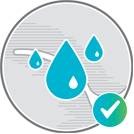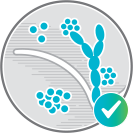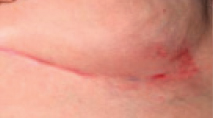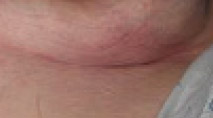Intertrigo Complications & Solutions
The Challenge
For patients, initial symptoms include pain, itching, burning, erythema, satellite lesions, maceration, denudement and odor. It can affect patients’ quality of life and if left untreated, may lead to serious complications like secondary infection, cellulitis and panniculitis.1
There are four causes of intertrigo
1
Moisture gets trapped within skin folds and beneath devices where air circulation is limited.1
3
Macerated skin becomes inflamed and denuded providing a breeding ground for bacteria.1
2
Overly hydrated stratum corneum does not glide on opposing skin surfaces, leading to friction damage.1
4
Fungus may develop on macerated, inflamed, denuded skin.1
There are four causes of intertrigo
1
Moisture gets trapped within skin folds and beneath devices where air circulation is limited.1
2
Overly hydrated stratum corneum does not glide on opposing skin surfaces, leading to friction damage.1
3
Macerated skin becomes inflamed and denuded providing a breeding ground for bacteria.1
4
Fungus may develop on macerated, inflamed, denuded skin.1
Traditional therapies offer incomplete relief
Treatments such as antifungal powders, creams and absorptive material target only one or two causes associated with intertrigo.1
• Antifungals only target the fungus, but fail to properly address bacterial growth, reduce friction and move moisture away from the skin.1
• Linens such as bedsheets and pillow cases are usually ineffective as they absorb moisture but do not allow it to evaporate, promoting skin damage and have no ability to inhibit fungal and bacterial growth.1

Moisture
Wicks and translocates moisture away from the skin with 100% polyester fabric

Friction
Minimizes friction with polyurethane coating

Bacteria
Fights bacteria with antimicrobial silver in the fabric

Fungus
Fights fungus with antimicrobial silver in the fabric
To resolve intertrigo, it’s critical to target all four causes of the damage
InterDry® with FourFold Technology™ is an innovative moisture wicking fabric with antimicrobial silver proven to provide real symptom relief of intertrigo and prevent further skin damage from occurring.
CASE STUDY: UNDER THE BREAST4
CASE STUDY: UNDER THE BREAST4
Symptoms: erythema, denudement, maceration,
satellite lesions, itching/burning
- Length of treatment time
- Treatment cost
- Outcome

Antifungal protocol (oral and topical)
- 84 days
- $104.16
- not resolved

InterDry protocol
- 5 days
- $2.77
- completely resolved
